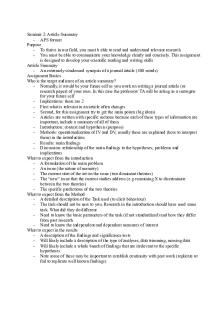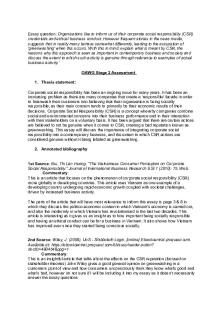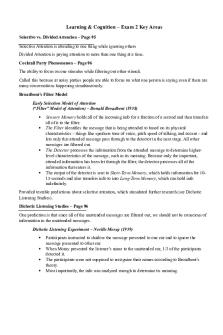2 Biodiversity - Lecture notes 2 PDF

| Title | 2 Biodiversity - Lecture notes 2 |
|---|---|
| Author | Ngoc Huynh |
| Course | General Biology |
| Institution | University of California Davis |
| Pages | 33 |
| File Size | 7.4 MB |
| File Type | |
| Total Downloads | 16 |
| Total Views | 192 |
Summary
Laci...
Description
Global Patterns of Biodiversity
Dr. Laci Gerhart-Barley BIS 2B, Fall 2018
Opening Question What time of year is shown in this diagram? A. June
B. September
C. December
Clouds
Equator
D. March
E. WTF?
Learning Objectives • Calculate diversity indices for different ecosystems/habitats • Understand how species richness and species evenness contribute to overall diversity indices • Describe global patterns of biodiversity and the physical and historical factors that contribute to these patterns • Interpret species-area and rarefaction curves
Levels of Biological Diversity Variation in characteristics
Groupings of species by physical environment
Habitat or Ecosystem (river, lake, ocean)
Groupings of species by evolutionary relatedness or ecological role
Higher taxa (genera, orders, phyla) Functional groups (e.g., predators)
Different species occupying the same habitat at the same time
Species
Differences in genotypes of individuals of the same species Different phenotypes among individuals with the same genotype
Genetic Plasticity
WE ARE HERE
How do we measure diversity? Kansas wheat field
Exuma Cay, Bahamas sea grass bed
Kansas tallgrass prairie
Hanauma Bay coral reef
Which environment is more diverse? Site A
Site B
Quantifying Diversity Diversity Index D Species Richness total number of species in the habitat
Species Evenness relative abundance of each species
D = (p1-p1)(p2-p2)( p3-p3)…(pn-pn) p is the proportion of individuals of that species
Which ecosystem is more diverse? Site A
Site B
How much do we sample? • Species-Area curve • How the number of species found changes with area sampled
• Rarefaction plots • How the number of species found changes with number of individuals sampled
Species Area Curves A
A
C B D
A F
B C B
C
A
B
C
F D
B
E A
B
B
B C
C
E A
C
D
B
E
Total number of species (cumulative)
C
A
DC D D F A
G
A B C F
E
G
C
8 6 4 2 0
1
2
4
8 16 Cumulative area sampled (m2)
32
Mauffrey et al 2007
Rarefaction Curves
Global Diversity Camilo Mora Univ Hawai’i
Prediction: 8.7 mill species
Mora et al 2011
Question You are an ecologist studying species diversity at the Jepson Prairie Reserve. You collect the data shown in the rarefaction plot below. What do these data indicate to you?
Question You are an ecologist studying species diversity at the Jepson Prairie Reserve. You collect the data shown in the rarefaction plot below. What do these data indicate to you?
Biodiversity • Climate • Temp/Precip • Seasonality
• Vicariance • Tectonic Plate Movement • Sea Level Change
• Regional Factors • Rainshadow Effect
What Controls Climate?
Hawai’i
Biomes outlined by dashed line heavily impacted by seasonality and disturbance (fire, grazing)
Kansas
California
Where in the Earth’s orbit does the month of June occur? A
B
D C
Equinoxes and Solstices
Tilt and Solar Energy What time of year is shown in this diagram? A. Winter
B. Spring
C. Summer
D. Fall
E. None of these
Hadley Cell
Hadley Cell and Biomes
Intertropical Convergence Zone
Intertropical Convergence Zone What time of year is shown in this diagram? A. June
B. September
C. December
ITCZ
Equator
D. March
E. WTF?
Vicariance • The geographic separation of a species into separate populations through some form of physical barrier Tectonic Plate Movement
Oxbow Lake Formation
Plate Tectonics
Plate Movement
Penguins of the World
Oldest fossil, ~62 mya
The Panamanian Land Bridge
Permian 225 MYA
Jurassic 135 MYA
Triassic 200 MYA
Cretaceous 65 MYA
Present Day
Islands and Sea Level 400,000 years ago, could an animal have walked from Mindanao to Samar? A. Yes B. No C. I have no idea what any of this means
Wallace’s Line
Alfred Russell Wallace
Regional Climate Factors How does the rain shadow effect impact patterns of diversity in montane ecosystems?
WEST
EAST
(Sacramento)
(Reno)
12000ft 10000ft
S Lo dg e
8000ft
i ne f u b a lp
pole
F ir F & Red
Y e llo w
6000ft 4000ft F
wood oothill
orest o r e st
p i ne
la n d s
er -J u n i p n o y n i P and Woodl
Sagebrush scrub
2000ft Valley grassland Rainfall
20
40
60
80
20
< 10
Regional Climate Factors Which region would you expect to be the DRIEST? A. The windward side of the Coast Ranges B. The leeward side of the Coast Ranges C. The windward side of the Sierra Nevadas D. The leeward side of the Sierra Nevadas
Understanding Rain Shadows In what direction are air masses moving? A. B. C. D. E.
From north to south From south to north From east to west From west to east What?...
Similar Free PDFs

2 Biodiversity - Lecture notes 2
- 33 Pages

2 - Lecture notes 2
- 5 Pages

Lecture notes, lecture 2
- 3 Pages

Chapter 2 - Lecture notes 2
- 30 Pages

Blaw 2 - Lecture notes 2
- 4 Pages

Chapter 2 - Lecture notes 2
- 4 Pages

Seminar 2 - Lecture notes 2
- 2 Pages

Stage 2 - Lecture notes 2
- 3 Pages

Micro 2 - Lecture notes 2
- 18 Pages

2 Sources - Lecture notes 2
- 4 Pages

Prof 2 - Lecture notes 2
- 3 Pages

Mast200 2 - Lecture notes 2
- 3 Pages

Quiz-2 - Lecture notes 2
- 7 Pages

Chapter 2 - Lecture notes 2
- 11 Pages

Chapter 2 - Lecture notes 2
- 4 Pages

Exam 2 - Lecture notes 2
- 5 Pages
Popular Institutions
- Tinajero National High School - Annex
- Politeknik Caltex Riau
- Yokohama City University
- SGT University
- University of Al-Qadisiyah
- Divine Word College of Vigan
- Techniek College Rotterdam
- Universidade de Santiago
- Universiti Teknologi MARA Cawangan Johor Kampus Pasir Gudang
- Poltekkes Kemenkes Yogyakarta
- Baguio City National High School
- Colegio san marcos
- preparatoria uno
- Centro de Bachillerato Tecnológico Industrial y de Servicios No. 107
- Dalian Maritime University
- Quang Trung Secondary School
- Colegio Tecnológico en Informática
- Corporación Regional de Educación Superior
- Grupo CEDVA
- Dar Al Uloom University
- Centro de Estudios Preuniversitarios de la Universidad Nacional de Ingeniería
- 上智大学
- Aakash International School, Nuna Majara
- San Felipe Neri Catholic School
- Kang Chiao International School - New Taipei City
- Misamis Occidental National High School
- Institución Educativa Escuela Normal Juan Ladrilleros
- Kolehiyo ng Pantukan
- Batanes State College
- Instituto Continental
- Sekolah Menengah Kejuruan Kesehatan Kaltara (Tarakan)
- Colegio de La Inmaculada Concepcion - Cebu